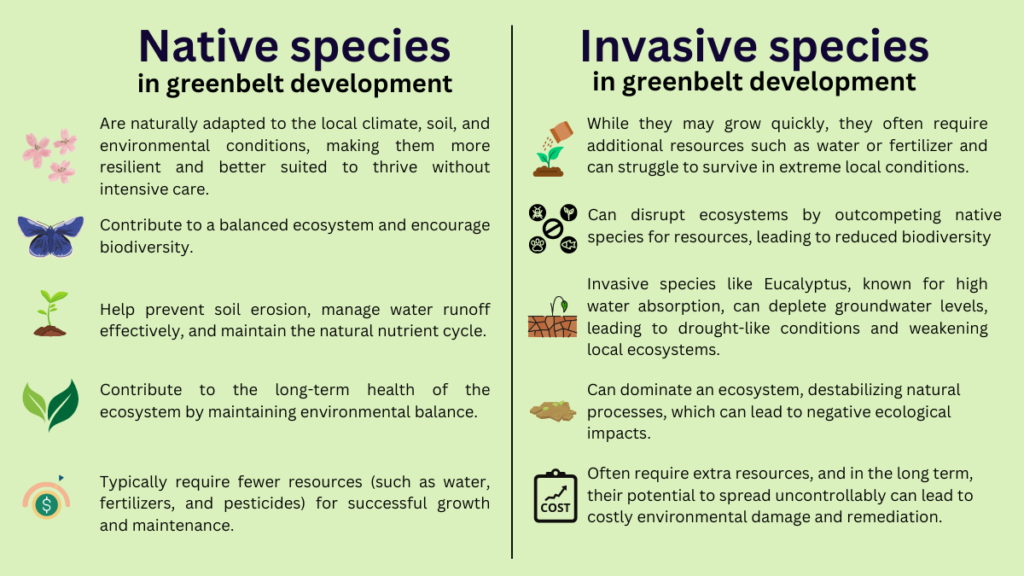



Copyright infringement not intended
Picture Courtesy: THE HINDU
The global effort to simplify industrial norms for improving the 'ease of doing business' is sparking a debate over whether relaxing mandatory environmental regulations, such as those for on-site green cover, compromises long-term ecological resilience for short-term economic convenience.
India's pursuit of rapid economic growth and investment creates a policy conflict: balancing 'Ease of Doing Business' (EoDB) with ecological resilience. Experts raised concern over environmental regulations, especially industrial green belt norms.
India's focus on becoming a global manufacturing hub through initiatives like 'Make in India' requires faster project clearances and a reduction in regulatory burdens for industries.
The dilution of green belt norms is seen as a quick way to lower compliance costs and speed up industrial approvals, creating a direct conflict between short-term economic incentives and long-term environmental sustainability.
An industrial green belt is a designated area of land around an industrial unit planted with specific trees and vegetation.
As per the Central Pollution Control Board (CPCB) guidelines, industries are required to develop a green belt covering up to 33% of their total project area to act as a buffer against pollution.
Functions of Green Belts
Pollution Control: They act as natural sinks for air pollutants (like SO₂, NO₂) and help trap particulate matter.
Noise Attenuation: Vegetation acts as a natural barrier, reducing noise pollution from industrial operations.
Micro-climate Regulation: They help moderate local temperatures and humidity, providing a cooling effect in industrial zones.
Soil and Water Conservation: They prevent soil erosion and can aid in groundwater recharge.
Limitations of On-site Green Belts
Fragmented Impact: Small, isolated patches of green cover around a factory cannot compensate for the large-scale ecological damage caused by habitat destruction or resource extraction.
Monoculture Plantations: Industries often plant non-native, fast-growing monoculture species (like eucalyptus), which offer limited biodiversity value and can negatively impact local soil and water tables.
Symbolic Compliance: Often, green belts are treated as a box-ticking exercise rather than a scientifically planned ecological intervention, limiting their effectiveness.

Core Conflict: Economic Growth vs Environmental Norm
The central conflict arises from viewing environmental regulation as a cost rather than an investment in long-term resilience. This creates a false dichotomy between economic growth and ecological health.
|
Arguments for Relaxing Norms |
Ecological & Economic Counter-Argument |
|
Reduces Compliance Costs: Land acquisition and maintenance of green belts add to project costs. |
Increases Long-Term Risks: Environmental degradation leads to higher operational costs from water scarcity, resource depletion, and climate-related disasters. The economic cost of air pollution in India is estimated to be over $95 billion per year, or about 3% of its GDP. (Source: World Economic Forum) |
|
Faster Project Clearances: Simplified environmental norms speed up the approval process, attracting investment. |
Erodes Natural Capital: Weakened norms damage ecosystems that provide essential services (clean water, pollination, climate regulation), which form the foundation of sustainable economic activity. |
|
Land Availability: Frees up land within industrial premises for operational expansion. |
Impacts Public Health: Increased pollution from relaxed norms leads to higher public health expenditure and reduced workforce productivity. |
From On-site Compliance to Landscape-Level Restoration
Instead of focusing solely on a factory's boundary, the regulatory framework should encourage industries to contribute to the ecological health of the entire region.
It aligns with the principles of Nature-based Solutions (NbS) and helps India meet Nationally Determined Contributions (NDCs), such as creating an additional carbon sink of 2.5 to 3 billion tonnes of CO2 equivalent through additional forest and tree cover by 2030.
Two-Tier Regulatory Framework
|
Regulatory Framework |
Key Actions |
|
On-Site Responsibilities (Mandatory) |
|
|
Off-Site Obligations (Flexible & Market-Based) |
|
Leveraging Technology for Smart Monitoring
Remote Sensing & GIS: Use satellite imagery and GIS mapping to accurately monitor the creation and health of green belts and off-site restoration projects, ensuring transparency and accountability.
Performance-Based Incentives: Link tax benefits or faster clearances to industries that demonstrably exceed ecological standards and achieve positive environmental outcomes.
Community Monitoring: Involve local communities in monitoring ecological restoration projects to enhance transparency and ensure local benefits.
India's path to sustainable growth lies in replacing symbolic, fragmented environmental compliance with innovative, science-based regulation that integrates industries as partners in landscape-level ecological restoration, ensuring a climate-proof and future-ready economy.
Source: THE HINDU
|
PRACTICE QUESTION Q. "On-site green belts are like first aid for a wound—necessary but localized." In light of this statement, critically analyze the limitations of India's current industrial greening policy. 150 words |
An industrial green belt is a mandatory plantation of trees and shrubs within and around an industrial facility. According to CPCB guidelines, its primary purpose is to act as a local buffer to mitigate pollution by trapping particulate matter, absorb gaseous pollutants, reduce noise levels, and regulate the local microclimate.
They are inadequate because they are merely mitigative, not restorative. They are often monocultures of non-native species with low biodiversity ("green deserts"), fail to replicate complex ecosystem services like groundwater recharge, and are too small and fragmented to support resilient ecosystems or wildlife corridors.
Announced in 2023, the Green Credit Programme is a market-based mechanism in India designed to incentivize voluntary environmental actions. It allows individuals and companies that undertake activities like afforestation or water conservation to earn "green credits," which can then be traded on a dedicated platform.
© 2025 iasgyan. All right reserved